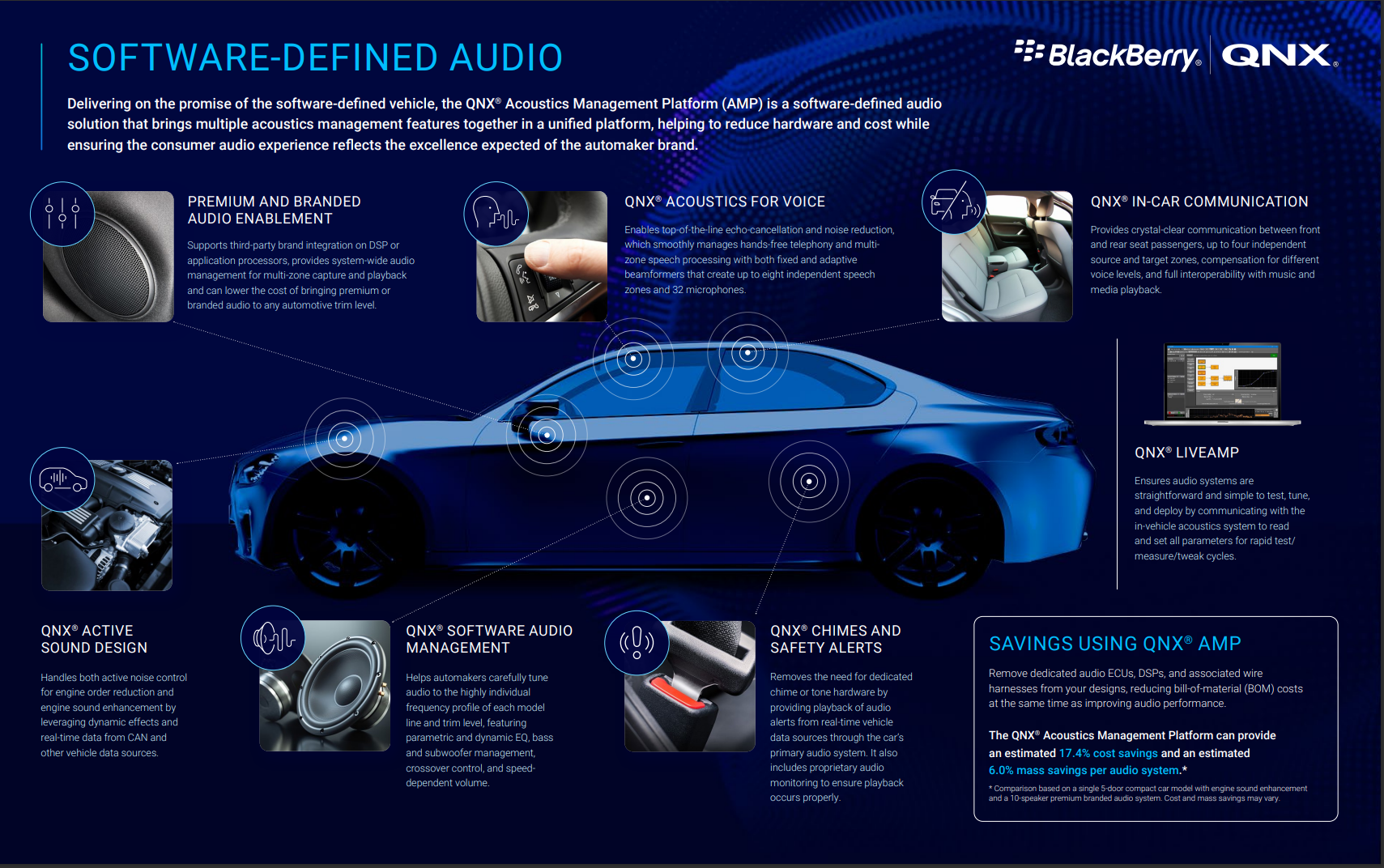Automotive Acoustics: A Solution to Combat Complexity
Whether it’s inside the car cabin or outside the vehicle, improper processing of audio can result in feedback, noise, and overall poor-quality sound – ultimately delivering a negative audio experience to consumers, instead of one that’s brand-enhancing. Achieving an effective automotive acoustic experience is complex, and involves careful orchestration of multiple independent audio inputs and sources.
I touched on some of the challenges that automakers face in my earlier blog, Automotive Acoustics: How to Address Complexity. In fact, I believe there are seven key challenges to address. Now, let’s explore them in greater detail.
Overcoming the 7 Challenges of Automotive Acoustics
The seven automotive acoustics challenges are listed below. For each one, I have included information on how BlackBerry offers a specific way to overcome the challenge, based on components of our QNX® Acoustics Management Platform (AMP).
1. Acoustics for Voice– The most demanding in-vehicle audio application is managing phone calls – providing clear-sounding speech without echoes or feedback, capturing a person’s voice while eliminating in-cabin and road noise. As a top echo-cancellation and noise reduction solution, QNX® Acoustics for Voice manages hands-free telephony and multi-zone speech processing.
Part of the clarity it delivers is from having fixed and adaptive beamformers (which use an array-based measurement technique to enable easy, one-shot measurement for mapping relative sound pressure and sound intensity contribution from a source) that can create up to eight independent speech zones (using inputs of up to 32 microphones), and then using these zones to steer an audio “bubble” to capture sounds from a person’s mouth and nothing else. Even with a single microphone and no beamforming technology, QNX Acoustics for Voice offers echo cancellation and noise reduction with sample rates up to 48KHz, along with support for Bluetooth™ protocols, as well as connectivity with Apple CarPlay® and Android Auto™.
2. Acoustics for In-Car Communication – Helping emphasize and improve communication within the vehicle cabin is one way for premium brands to add value to the vehicle audio experience. Unlike hands-free calling, in-car communication must run continuously and transparently to capture front-seat-to-rear-seat conversations, while avoiding amplification of non-speech sounds. QNX® In-Car Communication is a market-leading option that provides clear communication between passengers, with up to four independent source and target zones that are fully automated, and have zone-independent gain control to compensate for different voice levels. It’s also fully interoperable with music and media playback.
3. Active Sound Design – Mitigating or enhancing engine sounds within the car, as well as constructing sounds for broadcasting outside the vehicle, are two related challenges that use the engine’s behavior to create a specific audio experience. QNX® Active Sound Design (ASD) is a comprehensive vehicle sound management solution that handles active noise control for engine noise reduction and engine sound enhancement by leveraging dynamic effects and real-time data from the controller area network (CAN) and other vehicle data sources.
The desktop-based ASD solution includes the audio test and diagnostics tool QNX® LiveAMP, and a platform-agnostic runtime library that implements all sound design features in the embedded target. Runtime technology is portable to a wide range of automotive embedded systems and to dedicated audio digital signal processors (DSPs). Deploying to production is a simple one-step process; ongoing tuning and adjustments are also possible using LiveAMP.
4. Software Audio Management – A vehicle’s interior has many disparate surfaces, at a multitude of angles, that reflect or absorb sound at different frequencies, all of which makes for a complex audio environment. QNX® Software Audio Management helps automakers carefully tune audio to the individual frequency profile of each model line and trim level. It features parametric and dynamic EQ (for up to 32 independent outputs), bass and subwoofer management, crossover control, and speed-dependent volume. It also includes end-user controllable tone settings
5. Chimes and Safety Alerts – Since all vehicles already have loudspeakers, it’s wasteful to add several independent audio clicker and buzzer modules for reminders and alerts. QNX® Chimes and Safety Alerts removes the need for dedicated chime or tone hardware by providing playback of audio alerts from real-time vehicle data sources through the car’s primary audio system. To ensure playback occurs properly, it includes proprietary audio monitoring that confirms audio output is detectable – ideal for safety systems. QNX Chimes and Safety Alerts also supports early audio warning interfaces using fast-boot technology, for any alerts that need to happen within milliseconds of power on or ignition.
6. Premium and Branded Audio Enablement – Adding premium audio or high-end audio brands to a luxury car line is a practice that automakers have long used to influence a customer’s buying decision. This strategy typically requires adding custom amplifiers, speakers, and wiring, which add weight and cost to a vehicle. Premium and Branded Audio Enablement is a software-only solution that allows automakers to incorporate audio-manufacturer algorithms into their infotainment designs, to deliver premium audio experiences without the added weight and cost of a hardware solution. This can also enable automakers to cost-effectively offer premium and branded experiences across lower trim levels, accessible to more consumers.
7. Acoustic testing & configuration – Having sophisticated audio algorithms is great, but if sound engineers can’t properly test, diagnose, or configure systems efficiently, they can waste huge amounts of time tinkering to find the right combinations to maximize the impact of those premium sound features. To ensure audio systems are straightforward and simple to test, tune, and deploy, QNX LiveAMP is a desktop audio test and diagnostics tool that communicates with the in-vehicle acoustics system to read and set all parameters for rapid test/measure/tweak cycles. Since it can inject and record audio and vehicle data at multiple tap-points, it provides the ideal platform for measurement and reproduction of audio profiles and events, as well as configuring reference microphones. It provides real-time spectral displays, an intuitive GUI, and can be used for offline sound design.
BlackBerry created a software-defined audio solution, QNX® AMP, with the seven different modules described above, to help automakers deal with the challenges discussed in this article. Ultimately, the goal is to allow those carmakers to create the ideal acoustical experience for each vehicle. This represents another important step in the evolution of
software-defined vehicles, since the solution reduces reliance on costly and heavy hardware, and it can support over-the-air downloads for fine-tuning and adding new acoustics features.
The
infographic below explains how our software-defined audio solution can help you cost-effectively deliver exceptional automotive audio experiences.
Bringing It All Together
QNX AMP was designed to deliver industry-leading algorithms and technology in a single acoustics package. Bringing multiple audio features into a unified platform, QNX AMP can help ensure that the consumer has the audio experience emblematic of the automaker’s brand. It also allows automakers to remove dedicated audio ECUs, DSPs, and associated wire harnesses from designs, reducing the bill of materials (BOM) costs while improving audio performance.
Sound design teams working to solve specific audio problems — or looking to incorporate some of the most advanced automotive audio algorithms and techniques into their vehicles — are encouraged to learn more about the QNX AMP solution.


